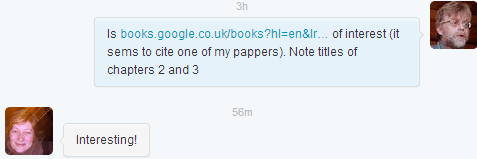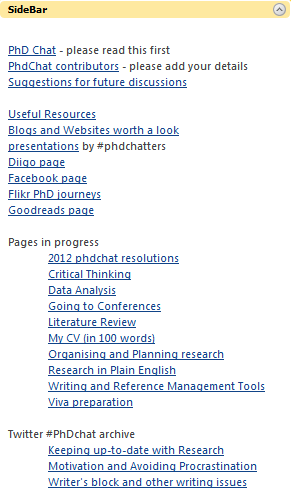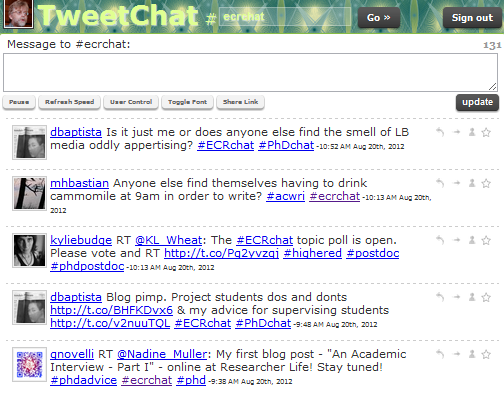CETIS Series of Analytics Briefing Papers
Adam Cooper, CETIS Director, recently published a post in which he tried to answer the question What does “Analytics” Mean? (or is it just another vacuuous buzz word?). In the post Adam asks the question:
But is analytics like cloud computing, is the word itself useful? Can a useful and clear meaning, or even a definition, of analytics be determined?
Adam concludes that “the answer is ‘yes’” and describes how this definition is explained in a CETIS briefing paper on What is Analytics? Definition and Essential Characteristics. Adam’s post also introduces the CETIS series of briefing papers on Analytics which includes papers on Analytics; what is changing and why does it matter?, Analytics for the whole institution, Analytics for Learning and Teaching, Legal, Risk and Ethical Aspects of Analytics in Higher Education, Analytics for Understanding Research and A Framework of Characteristics for Analytics.
The What is Analytics? Definition and Essential Characteristics briefing paper provides the following useful pithy definition:
Analytics is the process of developing actionable insights through problem definition and the application of statistical models and analysis against existing and/or simulated future data.
The CETIS work in this area has a focus on learning analytics, which reflects their core area of interest and expertise. However there are other areas of interest which are of relevance to the higher education sector. In addition there are approaches which have been taken to analytics beyond our sector which may provide useful insights.
Beyond Learning Analytics
Adam Cooper’s blog post concludes by encouraging people to focus on the applications of use of analytics, rather than seeking formal definitions:
Rather than say what business analytics, learning analytics, research analytics, etc is, I think we should focus on the applications, the questions and the people who care about these things.
I would agree with this approach. An example of possible dangers in focussing on the terms being used and the associated definitions can be see in the discussions surrounding altmetrics. As highlighted by Jean Liu in a post on Metrics and Beyond @ SpotOn London 2012:
A commonly held assumption about alt-metrics is that they are meant to replace traditional measures of research impact like citation counts. Actually most in the field (us included) think that alt-metrics should complement traditional metrics, not eliminate them altogether.
Although I recently commented on the need to understand the limits of altmetrics in a post on Understanding the Limits of Altmetrics: Slideshare Statistics in this post I want to focus on what I will refer to as performance analytics.
Performance Analytics in Sport and Hobbies
Wikipedia defines permance metrics as “a measure of an organization’s activities and performance. Performance metrics should support a range of stakeholder needs from customers, shareholders to employees“. We can see how such approaches can be applied in areas such as sports from the article published in the Guardian in August 2012 which described how Manchester City to open the archive on player data and statistics.
On a personal level in a post entitled Personal Perspectives on How Metrics Can Influence Practice I described the judge’s marks for last year’s rapper sword dancing competition (in which we came bottom of our group). The evidence of our low marks led to a decision to change our approaches to the dance, to the structure of the team and our weekly practices. The scores provided us with ‘actionable insights‘ into our performance which led to subsequent changes in behaviour.
I have noticed a growing interest in performance analytics across people I follow on Twitter, with a number of people in my network having purchased a Fitbit gadget and, judging my tweets I see in my Twitter stream, the Runkeeper app on their iPhone or Android device. If you’re looking for a Christmas present for a gadget-minded friend who is starting to think about their fitness the Duigital Trends Web site provides suggestions for Eight fitness gadgets that actually work.
Twitter Analytics
If metrics can provide insights into real world activities such as football, sword dancing, running and walking, then their relevance in a digital environment would appear obvious.
But should one care about performance analytics for activities such as use of Twitter?
John Spencer in a post entitled Twitter Isn’t a Tool has explained how he is unhappy with “organizations inquir[ing] about the best ways to maximize Twitter for professional development“. For John “Twitter isn’t a commodity“. Rather “Twitter is where I go when I want to talk to teacher friends … when I want to hang out with some teachers with my same quirky sense of humor [and] where people challenge my groupthink and push me to rethink my practice“.
@mr_brett_clark was in agreement: “I often describe Twiter like a party“. Curt Ress had a similar view: “I often see Twitter as a cocktail party. Lots of people having quick exchanges amidst a lot of noise. But through time, relationships are formed and real learning happens.”
But although Twitter may be an informal conversational medium which can enhance informal learning, I feel that others may agree with this characterisation and yet still find value in using analytics to “develop actionable insights”. After all although my hobby, rapper sword dancing, is a fun activity. there is widespread, although my no means universal, agreement that the judging and the competitive nature can improve standards.
And, of course, beyond Twitter’s role in informal learning and social intercourse, the tool is also being used to support formal institutional activities, as can be seen from the survey in August 2012 which showed that there have been almost 50,000 tweets from official Russell Group university Twitter accounts, which have over 300,000 followers.
Crowdbooster
 The Crowdbooster service allows you to:
The Crowdbooster service allows you to:
Analyze the performance of your individual tweets and posts with an interactive graph and table to quickly understand what’s working. Customize the date range to understand the impact of your campaign. Drill down to view engagement and reach metrics on Facebook and Twitter.
Use of the free version of the service is illustrated in the accompanying screenshot.
As can be seen you can view the potential impact of tweets on a daily, weekly, monthly basis, over all your tweets or for a customised range.
 As an example, I have an interest in seeing how the initial announcement of the date of the IWMW 2013 event has been shared across Twitter.
As an example, I have an interest in seeing how the initial announcement of the date of the IWMW 2013 event has been shared across Twitter.
It seems that there have been 11 retweets of the posts which have the potential to have been seen by 8.3K Twitter users. As Twitter users will know, this potential audience is unlikely to reflect reality. However it does provide an indication of outreach and the 11 retweets (and 2 conversations) are based on reality.
TwentyFeet
The TwentyFeet Web site describes how:
TwentyFeet is an “egotracking” service that will help you keep track of your own social media activities and monitor your results. We aggregate metrics from different services, thus giving you the full picture of what happens around you on the web – all in one place.
The TwentyFeet service (also known as 20ft) provides a range of graphs which help to visualise one’s Twitter performance over time. These include:

- Reputation influence: the numbers of followers gained and lost over a specified period together with the number of Twitter lists you are on.
- Influence indicators: the number of mentions and retweets.
- Conversations: including tweets, retweets and @ messages.
- Followers analyses: the numbers following you, people not following back and the rato of followers to following.
- List analyses: the numbers of lists you own, the numbers of members of lists you own and the number of subscribers to one’s lists.
- Additional information: the numbers of tweets you have favourited, the number number of tweets posted, the total number of links posted and the total number of lists followed.
Examples of TwentyFeet graphs for my numbers of followers in November 2012 are illustrated.
Business Models
The basic Crowdbooster service is available for free. As described on the pricing page this can be used to analyse one Twitter and one Facebook account. A Professional account, costing $39/month allows up to 10 accounts to be analysed with the Business account costing $99/month allowing up to 30 accounts to be analysed. No additional functionality is available for the paid-for accounts, apart from access to a live chat and phone support service,
The basic TwentyFeet service is available for free which can be used to analyse a single Twitter and Facebook account. However users of the free service will also find that the service sends a weekly tweet summarising the week’s performance, along the lines:
My week on twitter: 40 retweets received, 1 new listings, 37 new followers, 78 mentions. Via: http://20ft.net/p
Some people find such automated tweets irritating (with the tweet from TwentyFeet perhaps being regarded as boastful). It is possible to buy a subscription service which can be used to disable the public notifications as well as provide various other benefits. Subscriptions costs $12.45 for 5 credits – however it is not clear how long the credits last for.
Discussion
As mentioned previously many Twitter users may well have no interest in their Twitter metrics. However if you do have an interest, which service should you use? A similar answer would be to sign up for both. However the real decision to be made is probably whether to use the free version of TwentyFeet and accept the weekly automated tweets from one’s account.
Power Twitter users should have no difficulty in filtering tweets which are of no interest if they have a well-formed and consistent string of characters – which is the case for the alert from TwentyFeet as well as service such as paper.li (“The foo Daily is out“) and FourSquare (“I’m at foo http://4sq.com/bar“). Back in 2009 Mashable published an article entitled Twitter Better: 20 Ways to Filter Your Tweet. More recently posts on How to Filter out Noise from your Twitter Timeline and How to Filter Your Twitter Stream and a question on Quora which asked What tools can one use to filter one’s Twitter stream? highlighted some tools and techniques for Twitter management.
However many users will not wish to use such advanced filtering techniques. Perhaps in response to the public Twitter alerts provided by TwentyFeet, Crowdbooster now provides a private email alert. A few days ago I received s message saying:
You gained 7 followers a day over the past week! (On average, you gain 2) View your follower growth now.
To reach the most people, schedule your tweets for 12PM today, 8PM today and 9PM today.
In light of the developments to Crowdbooster I have just withdrawn permissions for TwentyFeet to post to my Twitter stream. The last tweet from the service was published 30 minutes ago:
My week on twitter: 45 retweets received, 8 new followers, 108 mentions. Via: http://20ft.net/p
For me, Crowdbooster provides the deeper understanding of how I use Twitter. I know know that my second most retweeted post ever was posted two years ago:
A classic for those who like spotting misuse of apostrophe’s – spotted in Bath charity shop. http://yfrog.com/h7bppsqj
It seems there are a lot of grammar pedants amongst my Twitter followers!
View Twitter conversation from: [Topsy]
51.379915
-2.331708
 Last week I attended a #LACEproject consortium meeting in Graz, Austria. The LACE project, which is funded by the EU, is “bringing together key European players in the field of learning analytics (LA) and educational data mining (EDM) in order to support the development of communities of practice and share emerging best practice“.
Last week I attended a #LACEproject consortium meeting in Graz, Austria. The LACE project, which is funded by the EU, is “bringing together key European players in the field of learning analytics (LA) and educational data mining (EDM) in order to support the development of communities of practice and share emerging best practice“. Some people may have concerns about the risks of sharing their location. It’s true that there can be risks in using one’s phone in dodgy areas, but this is not normally the case in airports. And my approach to minimising the risks associated with people knowing that I am not at home is to make sure I’ve locked the doors! I also shared my location when travelling on an extended trip to south east Asia as a way of ensuring that details of my journey were publicly available in case I had any problems on the trip.
Some people may have concerns about the risks of sharing their location. It’s true that there can be risks in using one’s phone in dodgy areas, but this is not normally the case in airports. And my approach to minimising the risks associated with people knowing that I am not at home is to make sure I’ve locked the doors! I also shared my location when travelling on an extended trip to south east Asia as a way of ensuring that details of my journey were publicly available in case I had any problems on the trip.





















 In addition to participating in the workshop sessions, Tony Hirst (@psychemedia) and myself facilitated a session on
In addition to participating in the workshop sessions, Tony Hirst (@psychemedia) and myself facilitated a session on 

























































You must be logged in to post a comment.